A Honey of a Day at Parma Park
Wranglers Test Out Mule-Driven Plow at Local Park
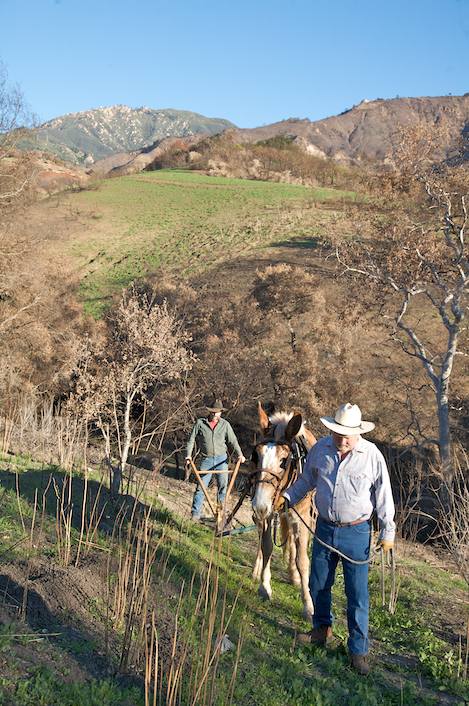
Can’t teach an new dog old tricks? Don’t tell Otis Calef that. Otis is a modern-day cowboy who loves to get out in the backcountry with his string of mules and enjoy the wilderness from the top side of a saddle.
Otis is the first person I look for when I’m thinking of sponsoring one of my week-long Working Vacation trail maintenance projects in the Dick Smith or San Rafael Wildernesses. With his mules to pack gear into the more remote parts of the backcountry we can do work that would otherwise be difficult to get done.
Today, I’m helping him unload his gear at Parma Park for a different kind of project – using mules to drive a plow. The difference here is that we aren’t here to till the fields; rather, Otis is testing a forty-year old piece of farm equipment to see how well it works on the trails.
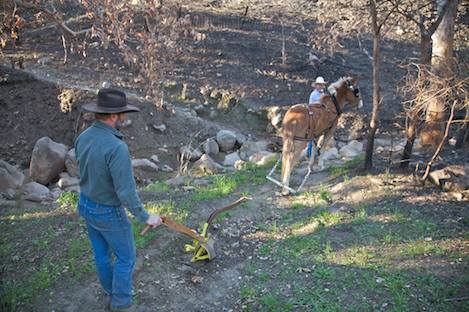
The idea of training his mules to do hand-driven work had been percolating about in Otis’ mind for quite a few years but it wasn’t until he purchased a Tennessee sorrel from a friend’s daughter that he got to thinking that the idea might actually be feasible.
Though Parma Park is still closed to the public because of fire damage, Otis has gotten special permission to test out Honey’s ability to pull the plow up a section of trail on the west side of the park. Working the plow is a two-man job and an old friend, Jim Bradburn, who owns a small ranch near Skofield Park where Otis stables his mules, is helping him get the harness on Honey. Jim will tend to the reins while Otis handles the plow. I’m amazed at how docile Honey appears to be.
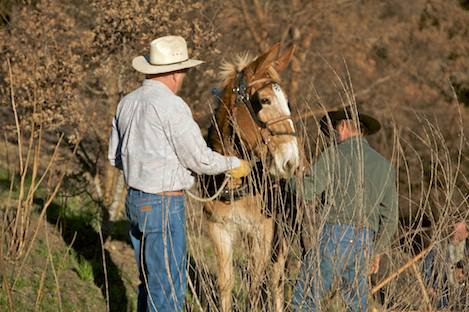
“Honey was huge for a mule, more the size of a draft horse when I got her,” Otis explained. “She was a bit wild and skittish, but I could see that she’d be perfect for pulling a low or grader up the trail. I just needed to put in the time to get her trail ready. At first, though, it wasn’t trail work that Otis had in mind. Honey seemed perfect for packing gear in the backcountry.
Over the next several months, however, while he was training Honey for trail riding, several things occurred to push the idea of using mules to rebuilding trails in the wilderness areas. The winter before the Zaca Fire Otis had attended a trail builder’s conference in Reno. One of the speakers was from Montana and his talk was on the use of horse teams to re-build worn out tread. Otis was intrigued: it not only confirmed the idea was a practical one, but the presentation convinced him he could use the techniques in our own backcountry.
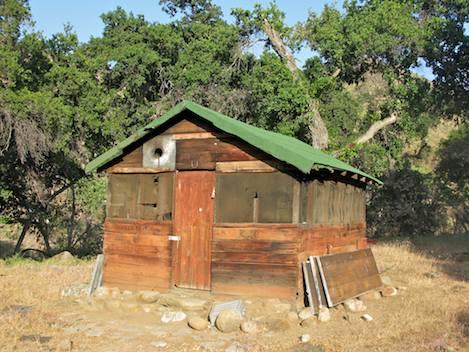
A few months later Otis took his scout troop on an overnight trip to South Fork Station, the last of the remaining Forest Service stations in the far reaches of the Santa Barbara backcountry. One of the troop’s duties was to help clean up the old cabin. “There was an old ladder leaning against a shed on the back side,” Otis remembered, “so I climbed up to check out the roof and there was this old #8 Vulcan Hillside Plow sitting up there. It wasn’t in good condition but it was perfect for trail work.”
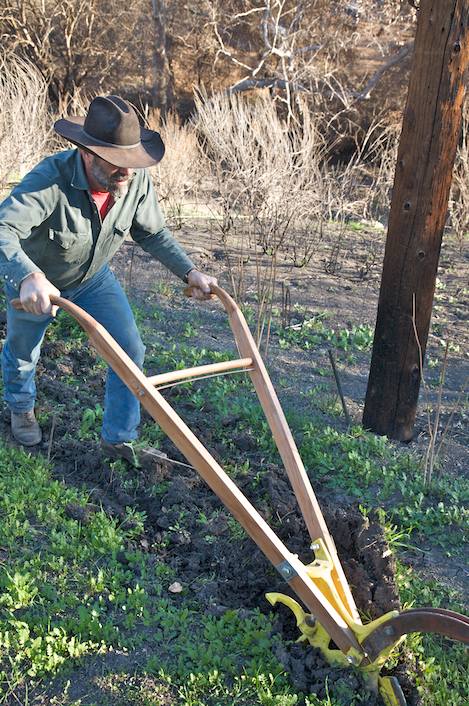
Unfortunately, it was too heavy for the scouts to carry it out, but despite that, Otis figured in just come in a few weeks later with his mules and haul it out. That plan didn’t quite work out. Not too long after, the Zaca Fire started and for the rest of the summer and early fall the South Fork was off limits.
Instead, Otis used the time to begin training Honey to the idea of pulling gear. “I talked to Dan Goodwin, a horse trainer in Buellton,” Otis said, “and Dan invited us over to his horse farm – Westwinds – for the day. He showed me the basics and got me off the ground. By the time I got Honey back to Santa Barbara, I had a pretty clear idea of what I needed to do.” With Jim’s help they worked on getting Honey to pull logs, old tires and even gunny sacks filled with tin cans – anything that would help acclimatize the mule to sounds that might spook her.
Towards November 2007, Otis finally got permission to take his mule string down to South Fork to retrieve the plow. With Jim bringing up the rear they worked their way down the Sweetwater Trail, picked up the plow and were back in Santa Barbara later than night.
The next day Otis took stock of the plow. There were no handles and it had a crack in the metal which needed to be repaired. “I Googled the name ‘Vulcan Hillside Plow’ online and found a company called Martin’s Harness in Farmersville, PA in Amish country that could make a new harness,” Otis told me. “I found another company called Yoder Plow Parts in Ohio but strangely enough there was no telephone number or email for the company – just a street address. So I sent them a letter, got a reply back and eventually was able to buy the handles from them.”
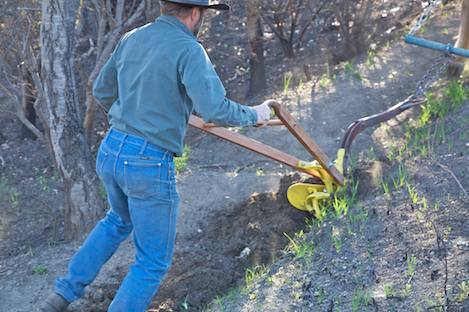
By this time, Otis had interested the Santa Lucia District Ranger, Kathleen Phelps, in the idea of using the plow in the Zaca Fire area to rebuild trail that had been lost to erosion. Kathleen not only was able to convince regional Forest Service officials that the idea of using the plow in wilderness was acceptable but she agreed to use some district funds to pay for the repairs.
As we work our way across a small creek at Parma, I can tell Otis is excited to see how well the plow will work. The section of trail he’s chosen for the test is about 18″ wide and has eroded enough that it is getting difficult to walk on. While Jim is in the lead to guide Honey where Otis wants her to go, Otis gets a good grip on the handles then signals Jim to start. “When it works well,” Otis tells me, ” the leading edge of the plow cuts into the soil about 6″ and flips the dirt to the outside part of the trail.”
The first pull seems to work well and the blade bites in. Then just as quickly it pops out when it hits a small rock. “Hold it!” Otis yells to Jim and they stop Honey. “See if you can’t get Honey to walk towards the uphill side of the trail,” he tells Jim. Otis can see that by directing the force of the plough into the hill a bit that the blade will dig in more and be harder to pop it out.
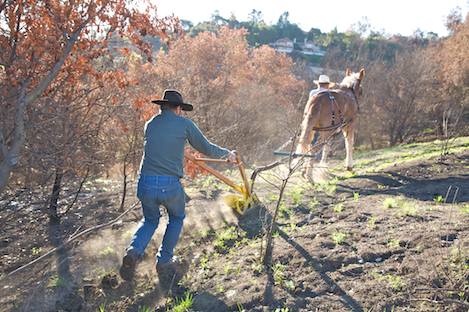
There are a dozen of these stop and starts before they begin to perfect the line they want to follow. After 15 minutes of adjustments to the harness, the lines connecting the plow and the angle Otis seems to have gotten the feel of the trail. Quickly they cut a hundred yards of tread, then turn around and re-cut it going downhill to see how Honey does. There’s not much difference: either direction works well. “It’s the angle,” Otis explains. “If Honey’s in the middle of the trail it’s really hard to keep the blade pointing into the hill. As long as we can keep Honey on the uphill side the plow works really well.”
Now that he’s got the technique down Otis switches out the plow for a crude dozer blade that is about 12″ high and 18″ wide. The idea is to push the loose soil that he’s just turned over with the plow diagonally off the trail as the blade moves along. This time it takes only a few starts and stops to get the angles right and after several passes the trail is in remarkably good condition.
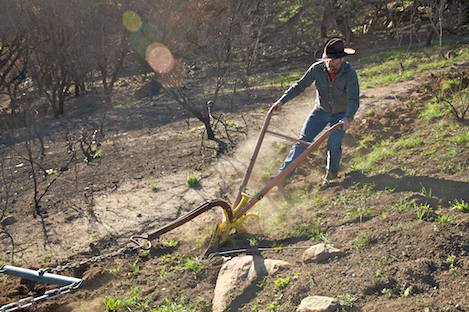
It’s taken Otis just under an hour to cut and blade about two hundred yards of trail and he figures the next section won’t take more than an hour now that he’s got the feel of things. “Now it won’t take more than a few minutes to clean up the remaining soil by hand and smooth things down,” Otis notes as he looks over his handiwork. As he and Jim take the gear back down to his horse trailer I can see he’s thrilled with the day’s efforts. The plow works.
Before we’re back down to the trailer I can hear Otis telling Jim that he’s ready to take Honey out into the backcountry to test the plow on a more hard core mountain trail. One trail in particular, the Santa Cruz Trail, is in serious need of help. There are 3-4 miles of loose dirt, gravel and rock that have come down the hill after the Zaca Fire, in places almost covering the trail completely. We’re talking hundreds of hours of work if it’s done by hand and $30,000 dollars of work – or more – depending on what happens the rest of the rainy season.
I can see Otis is itching to get Honey over there and to start cutting trail now that he’s got the feel of working with his #8 Vulcan Hillside Plow.



